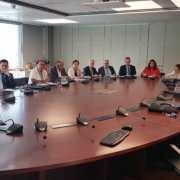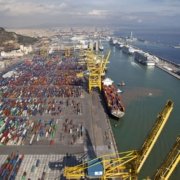Gerd-Michael Wuersig, DNV-GL’s business director for Alternative Fuels explains: “While hydrogen doesn’t come under the IGF code as yet, from my point of view I’d say the maritime industry’s hesitancy is more due to missing experience; most of the process technology and safety principles that relate to LNG will relate to hydrogen, and while there are different factors involved, in the end the risk level will not be very different. This is the good news.”
The bad news is that while your shipboard or bunkering design might look very similar, the components, like valves, hoses and piping are not necessarily interchangeable: “It’s a smaller molecule and it can escape through joints or seals that would retain LNG,” he adds. “You’d have to look to see if the current components would be suitable – but most likely I think you’ll have changes in your equipment,” says Dr Wuersig. And, he adds, it’ll work out quite a bit more pricey.
However, he also points out that the while it may be a novel application, the technology itself is not new.Joe Pratt underlines this point: “The equipment and expertise has been in existence for a long time. In North America, for example, LH2 production, handling, and distribution have been mature for over 50 years… So a lot of the components will come off the shelf.”
More, LNG developments can’t help much here as at this point the design deviates sharply. Two characteristics of LH2 are low density and low boiling temperature: together these demand an extremely low heat flux through the tank walls.
Dr Wuersig explains that the normal 40cm LNG insulation “just won’t work”. He says a moderately large LNG tank could lose 0.2% of its total volume a day but “store hydrogen in the same kind of tank and you would actually lose 5% of the contents every day to vaporisation”.
“Therefore to get down to roughly the same boil off rate the insulation of the hydrogen tank must be about 10 times more efficient than an LNG tank,” says Dr Wuersig. “In fact you need a system that is gas tight from the outside as well as the inside with no chance of the air finding its way into the insulation – if it does it will condense, and this will suck yet more air in.”
A multilayer approach with an evacuated space between the inner and outer shell is already being used to keep LH2 and liquid helium cold in the industrial sector, but there’s only one project so far – for a KHI-designed ship – that’s being scaled for the marine trading world, although the eventual development of larger vessels will have an advantage because higher capacity tanks exhibit a lower boil off rate.
There are other dissimilarities between LNG and LH2. Dr Pratt says when it comes to bunkering, “the biggest difference is the much colder temperature of LH2” and explains that unlike LNG, H2 is actually colder than oxygen or nitrogen. While LNG can hover at -163°C, liquid hydrogen needs to be kept at -253°C.
So, “even through vacuum insulation you will get very cold temperature on the outside of the pipe that can freeze or condense oxygen and nitrogen out of the air”. For practical purposes, not only do you need a very high grade of insulation, “there will be some drip pans and possibly restrictions on fuelling over asphalt to prevent any fire possibility as a result of having pure oxygen forming around the pipes”, said Dr Pratt.
BIG QUESTION
Hydrogen is already the chosen option for a number of smaller vessels with an environmental agenda: “Norway is working on constructing hydrogen fuelled vessels, mostly battery hybrids, as it is aiming for zero emissions in the fjords,” says Dr Wuersig. The autonomous Energy Observer, which electrolyses seawater for fuel, has recently set off on a six year missionand Dr Pratt is himself pursuing the build of a small, multipurpose freight carrier for California through GGZEM.
But, the most obvious question is: would hydrogen be a useful alternative for big ships?
First of all, bigger ships will need to bunker liquefied, not compressed, hydrogen. Dr Pratt says: “In general, it’s always better to go to LH2 if you can get it and afford the cost difference – it gives you more range or longer times between refuelling than gas, no matter what the size of the vessel.” This obviously needs the development of infrastructure – and here again, the industry experience with LNG will be invaluable – but on which kinds of vessels could it find a home?
Sandia’s research Practical Application Limits of Fuel Cells and Batteries for Zero Emission Vessels* (at the time lead by Dr Pratt), has dug deep into the nitty-gritty, with a look at no less than 14 possible ships and their associated routes.
This takes a detailed look not just at the power required, but whether the ship could actually accommodate the necessary architecture – helped of course by the fact that fuel cells, unlike a shaft drive engine, can be positioned in a variety of areas.
One of the 14 studies was the 397m Emma Maersk. Despite the large power and energy requirements, the research showed that the ship is able to hold a fuel cell powerplant using liquid hydrogen, scaled for a single voyage from Tanjung Pelepas, Malaysia to Port Said, Egypt with a total voyage time of 256hr at an average speed of 19.6 knots and average shaft power of 36.1MW. This would require bunkering with 616t of LH2.
Likewise, a detailed look at Colombo Express (335m) showed that it could carry out three of its typical, single trips between Singapore and Colombo, Sri Lanka, fuelled with 183t of LH2.
The devil is in the detail. Dr Wuersig points out that hydrogen has a low energy density by volume (though not by weight) which is only around 40% of that LNG. As already pointed out, LH2 isn’t heavy, but one tonne of it takes up over 14,128 litres by volume: this means 8,500m3 of LH2 for that Emma Maersk journey on LH2.
Could it be done? Yes, but it’s tricky as deep sea routes aren’t made up of single journeys. Taking the kind of operational profile that’s used onboard the latest LNG-fuelled CMA CGM ships which require an 18,000m3 tank installed underneath the wheelhouse, “you’d need 50,000m3 instead” he says. Further, he estimates the Asia-Europe string is 40 days: therefore the Emma Maersk would need around 72,000m3 to transit this on LH2 alone.
However, the case is different for shorter runs: according to the Sandia study, Colombo Express fairs better: 833m3 for that Singapore-Colombo single trip (2,500m3 for three journeys).
More, both agree that when it gets to ropax crossings like those between the east coast of the UK and Rotterdam, there’s obviously an advantage as it’s a short, regular, point-to-point journey “and you do need the infrastructure to deliver the hydrogen, something that’s caused other viable projects to fail” says Dr Pratt. Certainly Sandia’s investigation showed that Pride of Hull has room for a fuel cell and LH2 tank scaled for 15.8t of fuel, yielding no less than five crossings on just one fill up.
Dr Wuersig adds there are many other areas that might see hydrogen as a viable alternative for slightly larger ships on a regular run: “Baltic carriers for example, could benefit because they could be filling up every few days; then there’s the US-Hawaii traffic on the Jones Act ships.” More, he adds that Chinese river traffic is presently looking LNG, but there could soon be a lot of renewable energy capacity in China that might not all be easily absorbed by the grid “which might change the maths when it comes to the generation of sustainable fuels”.
It’s not just China, some of the windfarms and renewable arrays around offshore Europe are presently considering generating hydrogen in their off-peak periods.
More, Sandia’s study on the offshore supply vessel Maersk Frontier showed it could take on no less than 28 single trips (14 round trips) on the 166nm journey between home port in Aberdeen UK and the Janice offshore facility at an average 9.7 knots, so LH2 could be worthwhile for wider ranging applications. Even closer to realisation is Zero-V, a coastal research vessel concept by Glosten, Sandia and the Scripps Institution of Oceanography that’s just been given AIP by DNV GL. Supported by bunkering of its 11,000kg capacity tanks at four ports along the US West Coast, it will have a 10kn range of 2,400 nautical miles.
However, another niggling detail presents itself: LH2 is also expensive to create: “At present production costs alone come to around $2.00 per litre, that’s without the base feed,” says Dr Wuersig. And no, it probably won’t get a lot cheaper – it’s down to the physics. The amount of energy required for liquefying hydrogen takes a huge 30% slice out of the total, compared to about 5% for LNG.
This is one of the main reasons that hydrogen hasn’t already found a niche: however, we’ve not experienced this regulatory landscape before, points out Dr Wuersig. “If we keep to our carbon ambitions, then yes, there will be reason to employ hydrogen as one of a number of multiple fuel options.”
* Practical Application Limits of Fuel Cells and Batteries for Zero Emission Vessels (http://energy.sandia.gov/wp-content/uploads/2017/12/SAND2017-12665.pdf).
AMBIENT-LIQUID HYDROGEN TRANSPORT?
The LH2 demonstrator is not the first long-range hydrogen supply chain project targeting Japan.
Last year, Chiyoda Corp started to work on transporting hydrogen extracted from natural gas at an LNG plant in Brunei and delivering it to the city of Kawasaki in Japan – but rather than chilling to -253°C, the hydrogen is bound to a carrier substance and carried in simple chemical tankers which slot neatly into the existing supply-chain technology. No need for expensive cryogenics.
Transforming hydrogen into an ambient liquid means binding it with a carrier substance, such as toluene, converting it to methyl cyclohexane (MCH) by hydrogenation: three H2 molecules attach to every molecule of toluene. At the other end it’s reconverted to hydrogen gas, the toluene being recovered for the next round.
Professor Kazuyuki Ouchi, University of Tokyo explains that the density, while not quite as high as LH2 (500 times that of hydrogen gas, as compared to 700 times) “it is of the same order” so yields a tolerably similar output.
Interestingly, the project, which is expected to start production in 2020 with an output of 210 tonnes (enough to fill up 40,000 fuel cell vehicles), has Mitsubishi Corporation, NYK and Mitsui onboard.
More, while it’s starting with a fossil fuel base, Chiyoda believes that production will eventually move to renewably-derived hydrogen.
Source: The Motorship




